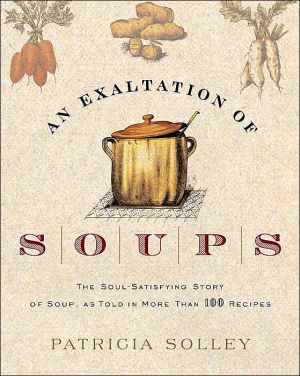Exaltation of Soups
Throughout history and around the world, soup has been used to bring comfort, warmth, and good health. A bowl of soup can symbolize so much—celebrations, major life passages, and the everyday. Inspired by Patricia Solley’s website, SoupSong.com, and organized according to function—soups to heal the sick, recover from childbirth, soothe a hangover, entice the object of your affection, and mark special occasions and holidays—An Exaltation of Soups showcases more than a hundred of the best soup...
Search in google:
Throughout history and around the world, soup has been used to bring comfort, warmth, and good health. A bowl of soup can symbolize so much—celebrations, major life passages, and the everyday. Inspired by Patricia Solley’s website, SoupSong.com, and organized according to function—soups to heal the sick, recover from childbirth, soothe a hangover, entice the object of your affection, and mark special occasions and holidays—An Exaltation of Soups showcases more than a hundred of the best soup recipes of all time, including: • Festive Wedding Soup with Meatballs from Italy• Egyptian Fava Bean Soup, made to give strength to convalescents• Creamy Fennel Soup with Shallots and Orange Spice from Catalonia—perfect for wooing a lover• Hungarian “Night Owl” Soup, designed to chase a hangover• Spicy Pumpkin and Split Pea Soup from Morocco, served to celebrate Rosh Hashanah• Tanzanian Creamy Coconut-Banana Soup for KwanzaaSpiced with soup riddles, soup proverbs, soup poetry, and informative sidebars about the lore and legends of soup through the ages, An Exaltation of Soups is a steaming bowl of goodness that is sure to satisfy. Publishers Weekly Solley's passionate compendium of history, folklore, literary references and recipes collects tidbits about and recipes for soup from all over the world. The author, who runs the SoupSong.com Web site, shares proverbs and quotes about soup's famed comforting qualities, and recipes for stocks, which are the foundation of all soups. She looks at the role soups can play in life's key moments: e.g., French "Boiled Water" Garlic Soup is traditionally served to convalescing new mothers; Guatemalan Lamb Soup with Tamales, with its robust, meaty content, is reserved for weddings and other fancy occasions; and Irish Cottage Broth for the Wake is "enough to bring the dead back to life." Next come "soups of purpose," that is, ones that supposedly assist in weight loss (Cabbage Soup), appetite stimulation (Creamy Crab and Cognac Soup) and healing (Fava Bean Soup from Egypt). There are also recipes to foster love (Lobster Sweetheart Soup) or cure a hangover (Beer Soup from Denmark). The clear and generally simple recipes are enhanced by informative and descriptive head notes; sidebars on such topics as the use of almonds as an aphrodisiac or the history of Japanese soy sauce; literary quotations and extracts; and personal stories. (Dec.) Copyright 2004 Reed Business Information.
Chapter 1\ Part I\ soup BASICS\ “amazing soup”\ Amazing soup! (how sweet the taste!)\ That fill’d a wretch like me!\ I once did hunger, now am sate;\ Did thirst, am now replete.\ ’Twas soup that filled my heart with pain And soup that pain reliev’d;\ How precious did that soup appear,\ When I was lost and grieved.\ Thro’ many sauces, salads and sweets,\ I have already bent;\ ’Tis soup that gratified my need,\ And soup that does content.\ The Lord has promis’d broth to me,\ His word my hope secures;\ He will my consommé provide,\ As long as life endures.\ Yes, when this meat and bone shall fail,\ And mortal life shall cease;\ I shall possess, within the veil,\ Some vichysoisse and peace.\ This earth shall soon dissolve like snow,\ The sun forbear to shine;\ But borscht, which call’d me here below,\ Will be for ever mine.\ –Jerry Newman, contemporary Canadian poet and novelist\ 1\ The Origins and History of Soup\ Stone Age people created soup before they had a pot to cook it in, a bowl to serve it in, or a gourd to drink it from.\ In fact, it’s not completely clear who first stumbled onto the concept of soup–anthropologists disagree, depending on their read of existing artifacts. Some say it was one of the Homo sapiens gang, sometime after\ 80,000 b.c.e.–either the Neanderthals or the Cro-Magnons who ultimately did those poor Neanderthals in. Others argue for a later generation–Neolithic man, around 10,000 b.c.e.\ I kind of like the Neanderthal theory. It was a particularly tough and dangerous world back then. These hunter-gatherers were stuck in the last blast of an Ice Age that killed off much of their food and many species. It was every man for himself as the Neanderthals ran fearfully from–and ran hungrily after–woolly mammoths, saber-toothed tigers,\ wolves, and other hominids. And yet elderly Neanderthal skeletons have been found in France with teeth worn down below gum level–and deeply crippled skeletons have been found, too. This means that some older or sickly prehistoric men had been kept alive only through the compassion of their communities and the brilliance of someone who could create hot and soupy food alternatives to incredibly cold indigestible plants and tough meat.\ I try to put myself under the toque of that Stone Age Julia Child. I imagine him or her using bark to dip and carry water . . .\ putting food in the water and noticing it soften or swell . . . marking how plants and berries, meat and marrow chunks would infuse the water with color and flavor. I imagine him or her getting the idea of warming the broth from the warm mother’s milk that kept little Neanderthal babies happy.\ Soup! It’s an unbelievable achievement–a matter of thought overreaching what was technologically possible at the time. In the words of anthropologist Sally McBrearty: “The earliest Homo sapiens probably had the cognitive capability to invent Sputnik . . . but didn’t yet have the history of invention or a need for those things.” But soup? Yes, he needed soup. He needed soup, so he imagined soup. He imagined soup, so he brought it into being, despite his lack of pots to cook it in.\ In fact, soup turned out to be a transforming concept that changed early man’s relationship to nature, increased his life choices, and created completely new needs and desires. One eon he’s a vegetarian in the garden of Eden, the next he’s scavenging or hunting raw flesh and sucking bone marrow . . . then, almost suddenly, he’s figured out an unbelievably complex process with tools to produce a hot meal. It’s a gastronomic miracle, and it’s art: multiple colors, multiple textures,\ multiple flavors–something created by man that had never existed before in the history of the world.\ But how on earth could early man in 10,000 b.c.e., at the latest, have boiled things . . . without the pottery that he finally created in 6,000\ b.c.e. and the cauldrons that followed in 3,600 b.c.e.?\ How Can You Make Soup Without Pots?\ I propose two theories.\ First, prehistoric man might have boiled animals in their skins. He could have flayed his prey, suspending the skin on forked sticks, filling the bag with water and food, and lighting a fire underneath. The skin would not catch fire because it would be cooked by the boiling water on the inside (but don’t try this trick at home). In fact, this technique has been used by many cultures in recorded history, from Scythians in\ fifth century b.c.e. to Irish and Scots in the sixteenth century.\ Second, our ancestors might have used the “hot stone” method. First you dig a hole or find one, and fill it with water. Then you build a fire close by and heat stones in it. Then, one by one, and\ v-e-r-y carefully, you transfer the stones to the water until it boils.\ And it will. Stones can be heated to a temperature of 1,300 degrees Fahrenheit in a well-laid hearth. How do I know that? Because in 1954,\ archeologist Michael J. O’Kelly proved it in experiments with his students at primeval Irish sites: “They used the hearths to heat stones, used a dampened wooden shovel to dump them in the water,\ brought the water to a boil, and simmered a 10-pound leg of mutton for\ 3 hours 40 minutes by adding stones every few minutes. . . . Then they ate the results: ‘excellently cooked and most tasty.’ ”*\ What Went into the Earliest Soups?\ After those first catch-as-catch-can soups of wild plants and animals,\ and after vast fields of grain sprang up in Europe and Asia, it turned out to be grains and beans–early man’s first agricultural triumphs in Neolithic times–that went into soup. By 7000 b.c.e., Emmer wheat had been domesticated in Turkey, and barley, millet, and beans in Greece.\ By 5000 b.c.e., rice was being cultivated in China. These were the stuff of early soups. And, of course, these remain our most revered modern comfort foods. Read on.\ Grains cooked in broth continue to be lovingly prepared in most cultures: porridges and gruels from ground wheat; couscous soups and farina soups; barley soups and tsampas; oatmeal soups and rice congee.\ Imagine the astonished look on ancient man’s face when he first witnessed the miracle of chemistry–when heating caused these cereal grains to release starch granules into the broth and make it thick.\ Bean/pea soup was in vogue long before Esau sold his birthright for it\ (that biblical “mess of pottage” was lentil soup), and it is an established part of every cuisine in the world without exception–every one! From feijoada in Brazil, to huku ne dovi in Zimbabwe, to misoshiru in Japan, and everything in between.\ And then there’s the ancient variation of ground wheat made into a bread that turns so hard without today’s modern preservatives that it can be made edible again only by pouring boiling broth over it. I know this bread from years I spent living in Morocco: that marvelous freshly baked kisra–a thick Frisbee of chewy bread–would turn to stone in 24\ hours. This is called “sop,” when dunked in hot liquid, the origin of our words soup, soupe, sup, sopa, soppe, zuppe, shorba, çorbasi. This combination is the basis of Portuguese sopa secos and asordas; Arabic shorbas; Spanish garlic soup; French panades, onion soup, and garbure;\ Italian aquacotta; Danish ollebrod, Estonian leivasupp, and French l’aïgo boulido. You’ll find an Egyptian fatta soup on page 248 whose very name means to break crisped pita bread into food.\ So there you have it. This part of our everyday cuisine, this soup that we take so much for granted, began life as a miracle of intellection,\ kept humankind alive through extremes of privation over the ages, and now serves to bind our common humanity, nurse our ills, and mark life’s passages.\ When I ponder soup, I think of ancient Tollund Man, dug out of a Danish peat bog in the 1950s and perfectly preserved. He’d been ritually sacrificed to the gods–strangled–but first given a fine last meal, still intact in his stomach. What was it? You know what it was: it was soup.\ A thick soup of grain and weed seeds ground in a hand mill and boiled.
Ch. 1The origins and history of soup5Ch. 2Proverbially soup9Ch. 3Soup reflections14Ch. 4Stocks and foundations20Ch. 5To celebrate and recover from giving birth35Ch. 6To celebrate religious confirmation47Ch. 7To celebrate marriage ... and recover from the rigors of the honeymoon51Ch. 8To honor the dead75Ch. 9To lose weight87Ch. 10To stimulate an appetite94Ch. 11To strengthen a convalescent109Ch. 12To woo a lover135Ch. 13To chase a hangover153Ch. 14New Year's Day175Ch. 15St. Tavy's Day (March 1)206Ch. 16Eastertide209Ch. 17Jewish history and festivals257Ch. 18Islamic festivals287Ch. 19Christmas305Ch. 20Kwanzaa338
\ Publishers WeeklySolley's passionate compendium of history, folklore, literary references and recipes collects tidbits about and recipes for soup from all over the world. The author, who runs the SoupSong.com Web site, shares proverbs and quotes about soup's famed comforting qualities, and recipes for stocks, which are the foundation of all soups. She looks at the role soups can play in life's key moments: e.g., French "Boiled Water" Garlic Soup is traditionally served to convalescing new mothers; Guatemalan Lamb Soup with Tamales, with its robust, meaty content, is reserved for weddings and other fancy occasions; and Irish Cottage Broth for the Wake is "enough to bring the dead back to life." Next come "soups of purpose," that is, ones that supposedly assist in weight loss (Cabbage Soup), appetite stimulation (Creamy Crab and Cognac Soup) and healing (Fava Bean Soup from Egypt). There are also recipes to foster love (Lobster Sweetheart Soup) or cure a hangover (Beer Soup from Denmark). The clear and generally simple recipes are enhanced by informative and descriptive head notes; sidebars on such topics as the use of almonds as an aphrodisiac or the history of Japanese soy sauce; literary quotations and extracts; and personal stories. (Dec.) Copyright 2004 Reed Business Information.\ \ \ \ \ Library JournalIn 1997, Solley launched SoupSong.com, a web site devoted to all things soup, and produces a monthly newsletter about soup. Now, in this well-researched, enjoyable book, she shares soup traditions, lore, new recipes, and contributions from other soup enthusiasts. While many cookbooks are organized by main ingredient, culture of origin, or season (e.g., Rick Curry's The Secrets of Jesuit Soupmaking), Solley first relates the origins of soup and whets our appetites with proverbs, quotes, and recipes for bases. Then the recipes are organized by function: soups to recover from childbirth, celebrate marriage, honor the dead, stimulate appetite, strengthen a convalescent, woo a lover, and chase a hangover. Finally, there are "Soups of Piety and Ritual," including recipes for Christian, Jewish, and Islamic festivals. Recipes are accompanied by quotes, poems, riddles, and sidebars-sometimes about soup but just as likely to be about an ingredient or ritual. More than just a practical book for cooks, this surprising book is fun for foodies and highly recommended for all public libraries.-Bonnie Poquette, Milwaukee, WI Copyright 2005 Reed Business Information.\ \








